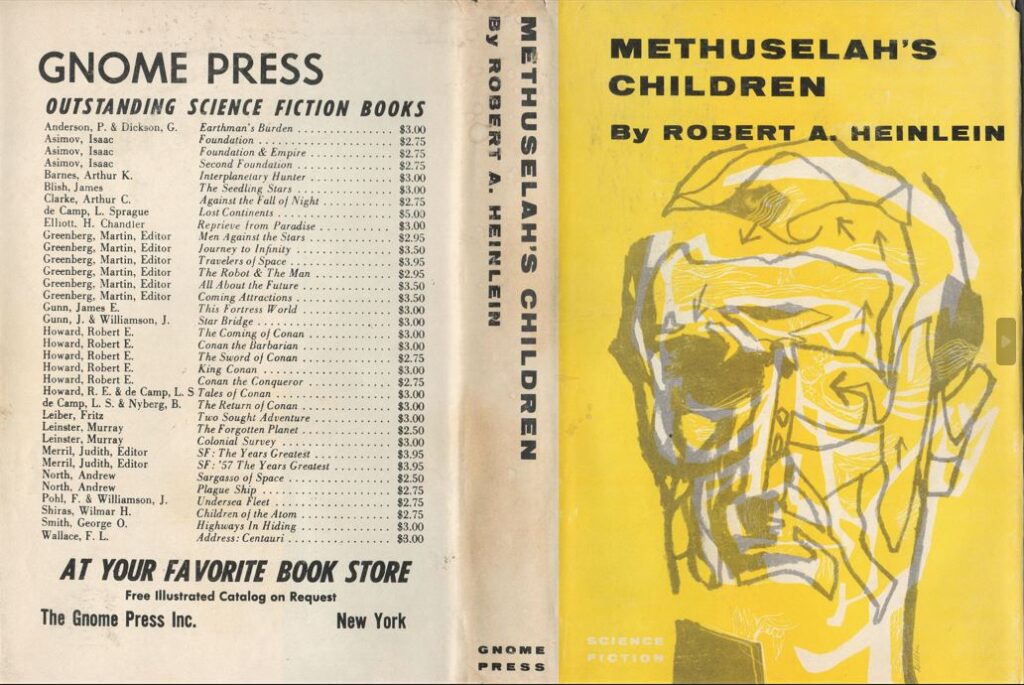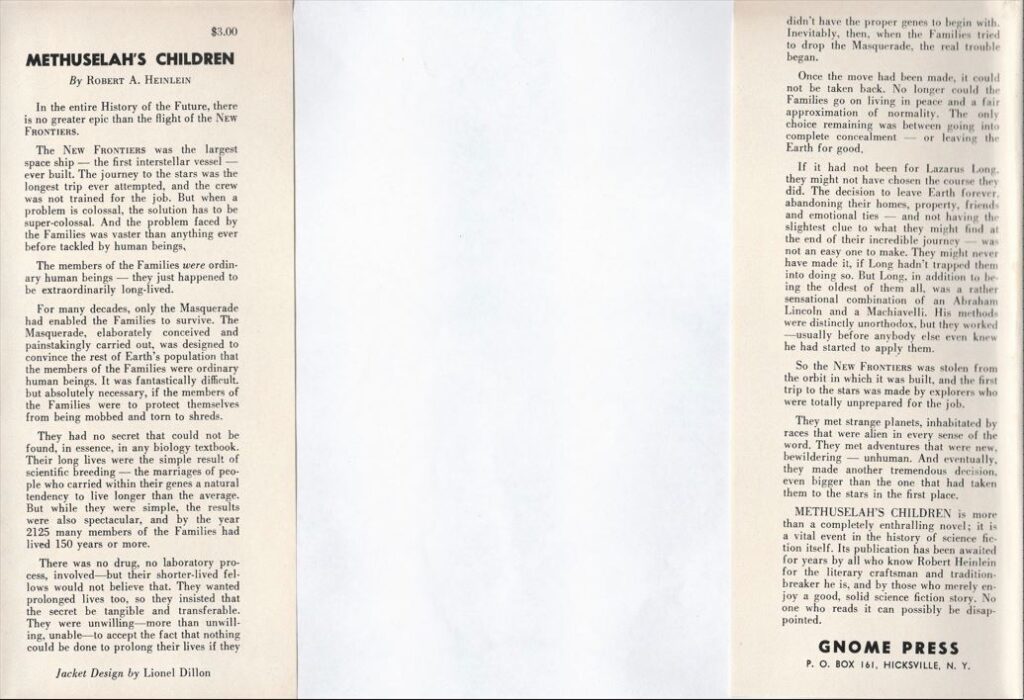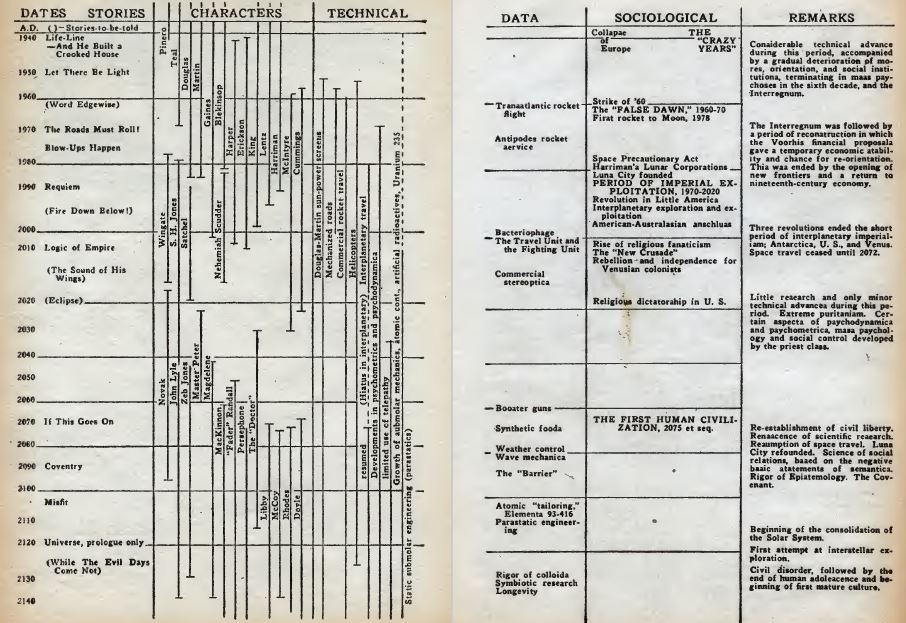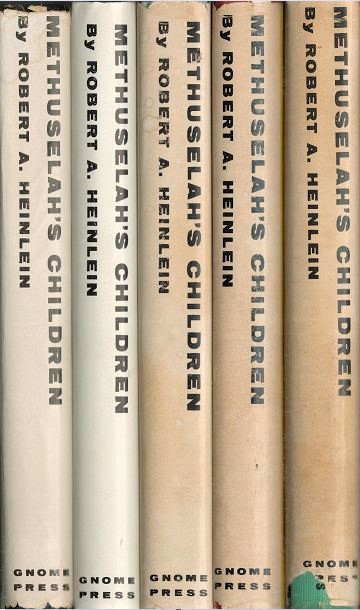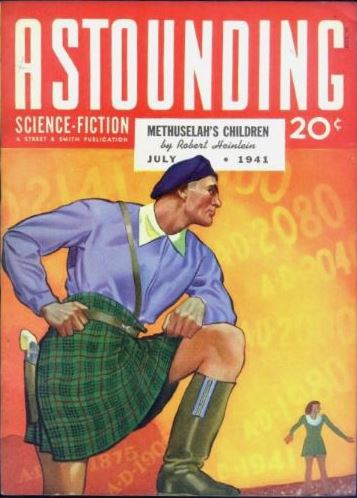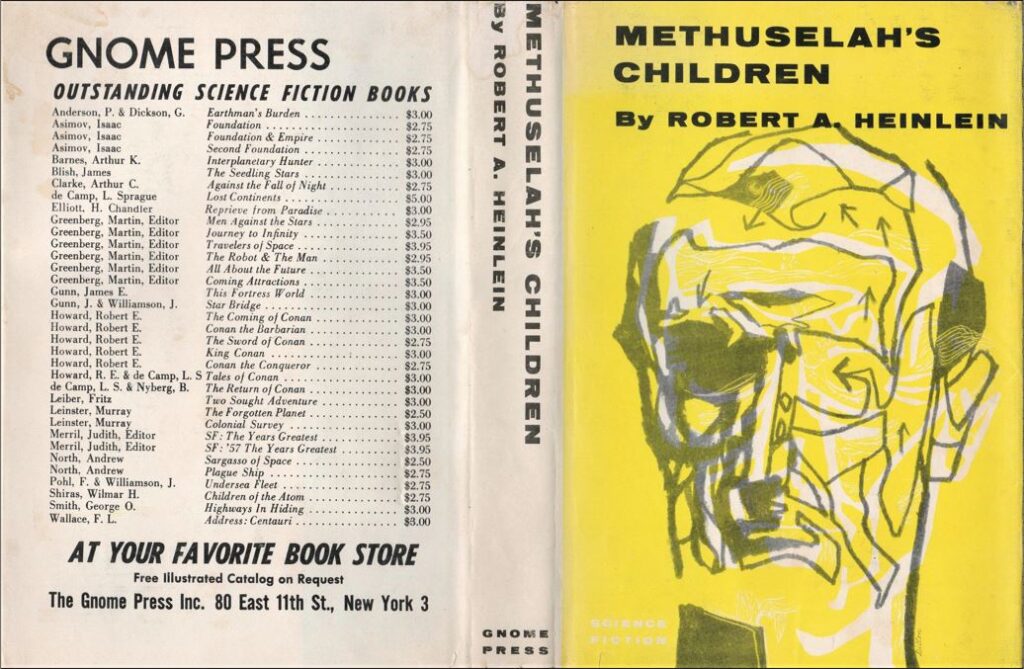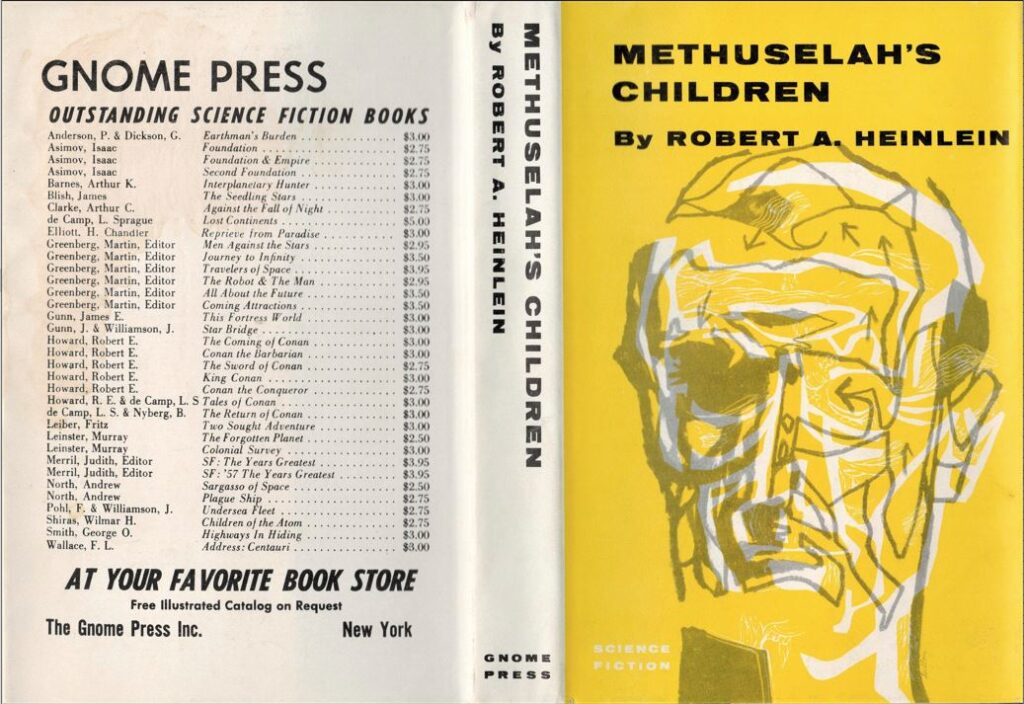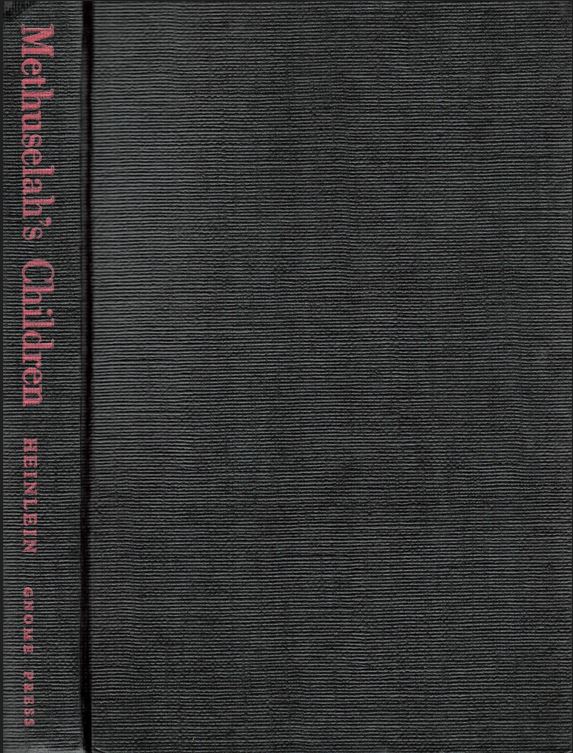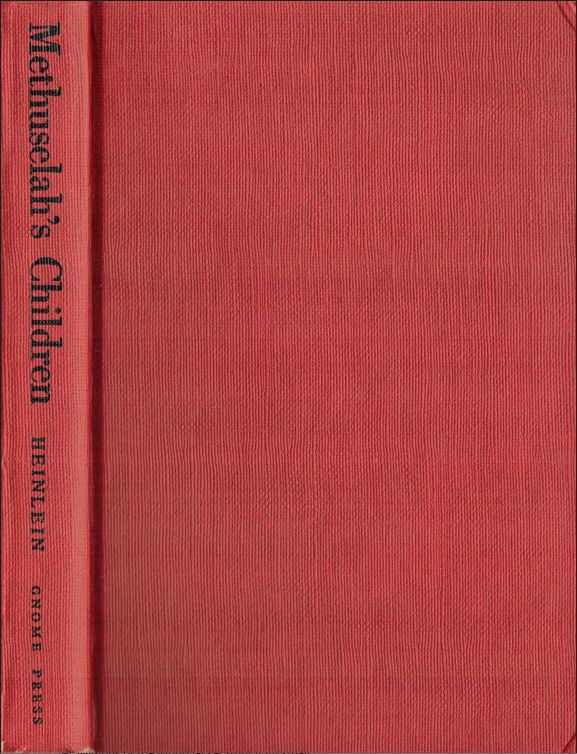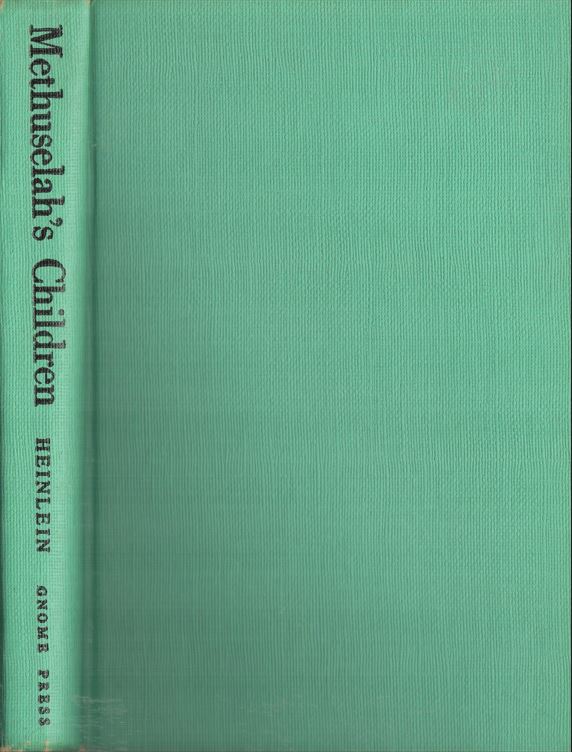Comments

Robert Heinlein’s Future History has a long and tangled history. His first published story, “Life Line,” didn’t shake the sf world, but in the next twelve months he added “Misfit,” “Requiem,” “If This Goes On…,” “The Roads Must Roll,” “Coventry,” and “Blowups Happen,” stand-outs each and every one. Moreover, all of them could be seen to inhabit a coherent world-to-be. John W. Campbell, his editor at Astounding, codified the obvious just as he had with Asimov’s Three Laws of Robotics. First, he shunted off the prolific Heinlein’s non-Future History stories to pen names (Lyle Monroe, Caleb Saunders, and Anson MacDonald [see Sixth Column]). Second, he printed a chart that spelled out exactly when in the future these stories were set as well as – this was the genius of the product – context in which to understand them. It appeared in the May 1941 Astounding as a “Heinlein History.”
The future is hard to predict. After just two more stories, America entered World War II and Heinlein stopped writing fiction for the interim. When he resumed in 1947, he traded on the sudden respectability of rockets and atomic power to sell stories to the highest paying mainstream markets, notably The Saturday Evening Post, near-future tales better suited for the mainstream audience. Although he’d only been in the field for three years before the war, by 1942 he’d reached parity with the top-ranked names. In 1947 he suddenly became the most famous science fiction writer in America.
The multitude of small presses took note. Each wanted Heinlein, or a piece of him. Fantasy Press scored the other Anson MacDonald novel, Beyond This Horizon, and rushed it out in 1948. Gnome bought Sixth Column in 1948 and put it into print in late 1949. Earlier in that same magical year of 1948, Erle Korshak, one of the three founders of Shasta Publishers, managed to lock down the core Heinlein stories by snagging Methuselah’s. The firm hadn’t yet published its first book and the advance was a pitiful $200 but Heinlein was at the moment in desperate need of money, not anticipating the crowd of publishers soon to be advancing toward him waving cash. He accepted. Later that year, Korshak proposed a grander plan: a five-volume series collecting the entirety of the Future History, including all the additional stories he’d announced that would fill in his chart’s blank years. Three story collections – The Man who Sold the Moon, The Green Hills of Earth, and Revolt in 2100 – appeared in 1950, 1951, and 1953. Methuselah’s Children would be book four. A bookseller’s ad in the February 1950 Astounding had the title listed, albeit as forthcoming. (Oddly, it did not mention the three books slated to precede it.) This, after many lean years, promised a profitable future.
Shasta effectively died in 1953, although they kept stringing along their authors with promises. One sf and one non-sf book were published in 1956 and those expenses in a doomed project were a gamble that destroyed all hope of a comeback. In 1983, ESHBACH reported the aftermath:
Rent hadn’t been paid for months for what then amounted to storage space, and the long-suffering landlord had gotten a court order, and a sheriff duly arrived and moved whatever was left out onto the sidewalk. By sheer chance, this was observed by an acquaintance of the Korshaks, and in minutes someone was guarding the stack until Korshak was reached, and the material was picked up by a nearby storage company. Carefully boxed and fully preserved, the books, artwork, etc., still remain in that same warehouse (with charges paid).
With Shasta dead, Heinlein offered Greenberg the rights to their volumes. Putting the Future History together would be a glistening prize for Gnome. (One wonders if Greenberg offered to buy any remaining unbound Heinlein from that storehouse; although no evidence exists to suggest this, it would have been a shrewd move.)
Gnome Notes
Bibliographically, Methuselah’s is the worst mess of all Gnome titles, a tangled skein of black thread swirling down a tiny drain in a crevice of an unlit cave, with only broken Waldoes available to feel through the wreckage. The record shows variants within variants and vaguely reported sightings of more variants which have seemingly never been imaged for independent verification. Even the standard references print and reprint confused and incorrect information.
Chronologically, the first statement on the books comes from the second edition of Owings and Chalker’s Index to the Science-Fantasy Publishers in 1966. This early stab strived more for completeness than internal precision. No more than the most basic information was included.
1500 copies; a 1000 copy reprint done in 1959 (identical)
Currey, in 1979, built on this slight foundation.
Two bindings, probably priority as listed: (A) Black boards, spine printed in red: (B) Gray cloth, spine printed in red. … Notes: According to Owings … there were 1500 copies of the first printing and a second printing in 1959 of 1000 copies. So far no copies of the second printing have been identified. (2) All dust jackets observed print the publisher’s address “80 East 11th St., New York 3” at base of rear panel. George Locke in Science Fiction First Editions (London: Ferret Fantasy, 1978), p. 87, reports a variant jacket with “80 East 11th St.,” and “3” removed.
ESHBACH corrected this wholly improbable listing of a mere 1500 copy printing of a Heinlein novel with better information directly from Greenberg. He gives the printing as 7500, the most ever.
The 1991 CHALKER expanded significantly on their earlier work. They accepted ESHBACH’s numbers but at times added new information on bindings not mentioned there.
Much has been made over how many “states” of this book exist. The answer is: two states, each with slightly different jackets, but without a d/w we can’t tell which is which. 5000 were bound in gray cloth in 1958, the other 2500 less than a year later in identical binding. The only difference we have so far determined physically is that the first binding’s jacket prints the New York City address. On second binding, mostly sold via Pick-a-Book, he simply omitted the address on the rear panel and put in the Box 161 (Hicksville) address on the back flap. Have fun.
CURREY 2002 makes one of his most sweeping revisions for any title.
Five bindings, last four later, probably sequence as listed: (A) Black boards, spine printed in red; (B) Gray cloth, spine printed in red; (C) Red boards, spine printed in black; (D) Green boards, spine printed in black; (E) Red cloth (reported, not verified). … Two (three?) printings of dust jacket, priority as listed: (A) 35 titles listed on rear panel. Two states (printings?), priority as listed: (1) Last line on rear panel reads: The Gnome Press Inc. 80 East 11th St., New York 3; (2) “80 East 11th St.,” and “3” removed; (B) 32 titles on rear panel. Address at base of rear panel reads: The Gnome Press Inc.,/P. O. Box 161, Hicksville, N.Y. Notes: (1) Binds A and B observed with jacket A1; Bindings C and D observed with jacket A2; Bindings D and E observed with jacket B. (2) Although rumors of a second printing persist, according to publisher Martin Greenberg there was a single printing of 7500 copies.
Deciphering the Rosetta Stone was somewhat easier than parsing that paragraph. I have endless space to work through the mess variant by variant so bear with me as I give it my best shot.
Starting at the top, the most often seen and most easily purchased is the CURREY (A) edition with black boards whose back panel reads The Gnome Press Inc. 80 East 11th St., New York 3. More copies are available online than any other Gnome title, confirming the massive printing. I have the gray cloth, red boards, and green boards, all of which have 35 titles on the back panels. I don’t have the red cloth variant, nor do I have a back panel with 32 titles. My cynical take is that the reports come from the same crowd of dealers who report boards as cloth. Extensive search has not brought up any images or even old auction listings for them.
Now to dive into the murk. The first edition black boards have two jackets, the Gnome address with and without 80 East 11th St., 3, i.e., CURREY (A) (1) and (A) (2). I also have the CURREY B, C, and D states, each of which has the bare The Gnome Press Inc, New York CURREY (2) jacket, missing the 80 East 11th St. address. However, these three have something in common with one another but not with the black boards: the spine and rear cover on both black board variants are a pure white, while the spine and rear cover on the other variants are a light tan. The tan coloring extends evenly across the entire expanse on both and extends onto the jacket front; it appears intrinsic to the printing rather than a mere darkening from later atmospheric changes. In good light, the contrast leaps out at you. Despite that obvious change, all the variants I’ve seen share the commonality that the rear flaps give the address of P. O. Box 161, Hicksville, N. Y on the rear flap even though that address is on none of the rear panels. In addition, the title page gives the firm’s address as Hicksville. (Despite the name, Hicksville is only about 15 miles from the New York City border.)
That Methuselah’s was given a 7500-copy printing is reasonable. The Big Three of Asimov, Clarke, and Heinlein were Gnome’s top sellers. While no previous book had had a first printing of that size, some multiple printings for Asimov and Clarke, along with Greenberg’s own anthologies, totaled 7500 copies or more. The unanswerable question is what happened next. The multiple dust jackets indicate that either the first printing was partitioned in some way – presumably for the cheaper PICK-A-BOOK copies that CHALKER mentions – or that a second printing was needed. All copies appear to have identical text and paper, although some have darkened even more deeply than the others. The black boards, however, are a hair slimmer than the other colors, just enough to be significant.
The varying addresses reflect Greenberg’s move from Greenwich Village to Long Island and one would think they could be used to lock down the dates of the variants. Unfortunately, Greenberg was wildly inconsistent as usual. A table makes this clear. The Gnome Press address always appeared in three places: the title page, the rear flap, and the back panel.
| Title | Copyright Date | Title Page | Rear Flap | Back Panel |
| All previous titles | Up until 8/25/1957 | New York | New York | New York 3 |
| The Shrouded Planet | 9/25/1957 | New York | Hicksville | Hicksville |
| They’d Rather Be Right | 10/25/1957 | New York | Hicksville | New York 3 |
| The Survivors | 2/25/1958 | Hicksville | Hicksville | Hicksville |
| Methuselah’s Children | 4/15/1958 | Hicksville | Hicksville | New York 3; New York |
| Undersea City | 7/1/1958 | Hicksville | Hicksville | Hicksville |
| All subsequent titles | 7/15/1958 and after | Hicksville | Hicksville | Hicksville |
Why Greenberg would release books with contradictory addresses for a full year is yet another mystery. The uniform use of Hicksville on The Survivors makes that title appear out of place, yet not only does it have the early 1958 registration date, it bears a 1957 Library of Congress catalog card number. But so does Undersea City. No outside evidence pins down the date of the CURREY (2) back panel, nor was it used on any other Gnome title.
The five states can therefore be divided in two ways: one with an address of The Gnome Press Inc. 80 East 11th Street, New York 3 and four with an address of The Gnome Press Inc. New York, or one with an address of The Gnome Press Inc. 80 East 11th Street, New York 3 and a white spine and back panel, one with an address of The Gnome Press Inc. New York and a white spine and back panel, and three with an address of The Gnome Press Inc. New York and a tan spine and white back panel.
My preference is to go with the latter. The first printing first state is the one with black boards, an address of The Gnome Press Inc. 80 East 11th Street, New York 3, and a white spine and back panel. Those boards were later wrapped with the same dust jacket but with the shorter address on the back panel. A second binding or printing of gray cloth, red boards, and green boards was created at a later time with the shorter address and darker spine and back cover. Because the boards are slightly different, I believe this is a true second printing, although whether that was in addition to a 7500 copy first printing or made the total 7500 copies is impossible to determine. I’ll add the 32-title dust jackets to my list of variants but I doubt their actual existence.
Each of my five copies has this statement on the copyright page:
An earlier shorter versien [sic] of this story was published/copyright Street & Smith Publications, Inc., 1941.
Eight billion variant bindings and dust jackets and no one could correct such an egregious typo? Signet managed the correction for 1960 paperback.
Kirkus Reviews gave the expected publication date as April 25, 1958.
Reviews
P. Schuyler Miller, Astounding Science Fiction, February 1959
Heinlein has improved a lot in the seventeen years since this story first appeared, but the inimitable touches are there.
Contents and original publication
• Part One, Chapters 1-8, and Part Two, Chapters 1-8 (rewritten from Astounding Science-Fiction, July, August, and September 1941).
Bibliographic information
Methuselah’s Children, by Robert A. Heinlein, 1958, copyright registration date 15Apr58, Library of Congress catalog card no. 58-6984, title #69, back panels #34,35,[36,37 not seen], 188 pages, $3.00. 7500 copies printed. Hardback. Jacket design by Lionel Dillon. Future History printed on front and rear endpapers except as noted. No first edition stated. No designated printer. P. O. Box 161, Hicksville, N. Y. on rear flap.
Variants, priority after 1) not known
1) (CURREY AA1) Black boards, spine lettered in red, dust jacket has white spine and back panel, 35 titles on back panel, Gnome Press address given as 80 East 11th Street, New York 3. Known priority.
2) (CURREY AA2) Black boards, spine lettered in red, dust jacket has white spine and back panel, 35 titles on back panel, Gnome Press address given as New York.
3) (CURREY CA2) Red boards, dust jacket has tan spine and back panel, spine lettered in black, 35 titles on back panel, Gnome Press address given as New York.
4) Gray cloth, dust jacket has tan spine and back panel, spine lettered in red, 35 titles on back panel, Gnome Press address given as New York. [Not in CURREY]
5) Green boards, spine lettered in black, 35 titles on rear panel, Gnome Press address given as New York. Future History not printed on rear endpapers. [Not in CURREY]
6) (CURREY BA1) Gray cloth, spine lettered in red, 35 titles on back panel, Gnome Press address given as 80 East 11th St., New York 3. [not seen]
7) (CURREY DB) Green boards, spine lettered in black, 32 titles on rear panel, Gnome Press address given as New York. [not seen]
8) (CURREY EB) Red cloth, 32 titles on rear panel, Gnome Press address given as New York. [not seen or verified]
Images
